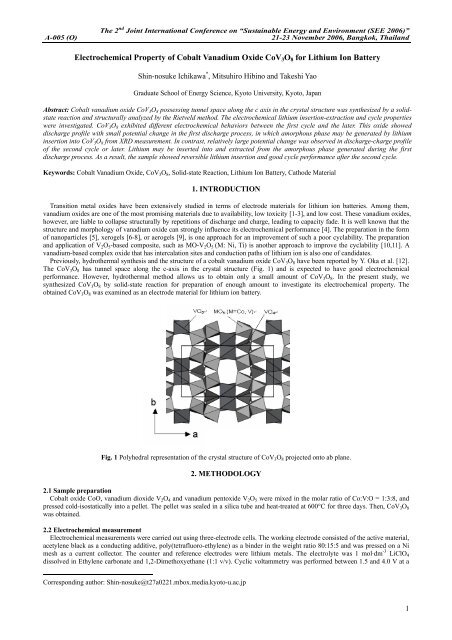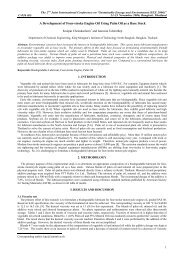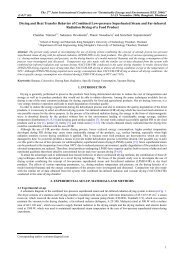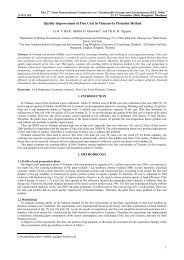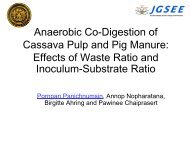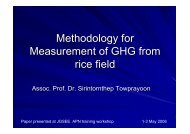Electrochemical Property of Cobalt Vanadium Oxide CoV3O8 for ...
Electrochemical Property of Cobalt Vanadium Oxide CoV3O8 for ...
Electrochemical Property of Cobalt Vanadium Oxide CoV3O8 for ...
Create successful ePaper yourself
Turn your PDF publications into a flip-book with our unique Google optimized e-Paper software.
The 2 nd Joint International Conference on “Sustainable Energy and Environment (SEE 2006)”A-005 (O) 21-23 November 2006, Bangkok, Thailand<strong>Electrochemical</strong> <strong>Property</strong> <strong>of</strong> <strong>Cobalt</strong> <strong>Vanadium</strong> <strong>Oxide</strong> CoV 3 O 8 <strong>for</strong> Lithium Ion BatteryShin-nosuke Ichikawa * , Mitsuhiro Hibino and Takeshi YaoGraduate School <strong>of</strong> Energy Science, Kyoto University, Kyoto, JapanAbstract: <strong>Cobalt</strong> vanadium oxide CoV 3 O 8 possessing tunnel space along the c axis in the crystal structure was synthesized by a solidstatereaction and structurally analyzed by the Rietveld method. The electrochemical lithium insertion-extraction and cycle propertieswere investigated. CoV 3 O 8 exhibited different electrochemical behaviors between the first cycle and the later. This oxide showeddischarge pr<strong>of</strong>ile with small potential change in the first discharge process, in which amorphous phase may be generated by lithiuminsertion into CoV 3 O 8 from XRD measurement. In contrast, relatively large potential change was observed in discharge-charge pr<strong>of</strong>ile<strong>of</strong> the second cycle or later. Lithium may be inserted into and extracted from the amorphous phase generated during the firstdischarge process. As a result, the sample showed reversible lithium insertion and good cycle per<strong>for</strong>mance after the second cycle.Keywords: <strong>Cobalt</strong> <strong>Vanadium</strong> <strong>Oxide</strong>, CoV 3 O 8 , Solid-state Reaction, Lithium Ion Battery, Cathode Material1. INTRODUCTIONTransition metal oxides have been extensively studied in terms <strong>of</strong> electrode materials <strong>for</strong> lithium ion batteries. Among them,vanadium oxides are one <strong>of</strong> the most promising materials due to availability, low toxicity [1-3], and low cost. These vanadium oxides,however, are liable to collapse structurally by repetitions <strong>of</strong> discharge and charge, leading to capacity fade. It is well known that thestructure and morphology <strong>of</strong> vanadium oxide can strongly influence its electrochemical per<strong>for</strong>mance [4]. The preparation in the <strong>for</strong>m<strong>of</strong> nanoparticles [5], xerogels [6-8], or aerogels [9], is one approach <strong>for</strong> an improvement <strong>of</strong> such a poor cyclability. The preparationand application <strong>of</strong> V 2 O 5 -based composite, such as MO-V 2 O 5 (M: Ni, Ti) is another approach to improve the cyclability [10,11]. Avanadium-based complex oxide that has intercalation sites and conduction paths <strong>of</strong> lithium ion is also one <strong>of</strong> candidates.Previously, hydrothermal synthesis and the structure <strong>of</strong> a cobalt vanadium oxide CoV 3 O 8 have been reported by Y. Oka et al. [12].The CoV 3 O 8 has tunnel space along the c-axis in the crystal structure (Fig. 1) and is expected to have good electrochemicalper<strong>for</strong>mance. However, hydrothermal method allows us to obtain only a small amount <strong>of</strong> CoV 3 O 8 . In the present study, wesynthesized CoV 3 O 8 by solid-state reaction <strong>for</strong> preparation <strong>of</strong> enough amount to investigate its electrochemical property. Theobtained CoV 3 O 8 was examined as an electrode material <strong>for</strong> lithium ion battery.Fig. 1 Polyhedral representation <strong>of</strong> the crystal structure <strong>of</strong> CoV 3 O 8 projected onto ab plane.2. METHODOLOGY2.1 Sample preparation<strong>Cobalt</strong> oxide CoO, vanadium dioxide V 2 O 4 and vanadium pentoxide V 2 O 5 were mixed in the molar ratio <strong>of</strong> Co:V:O = 1:3:8, andpressed cold-isostatically into a pellet. The pellet was sealed in a silica tube and heat-treated at 600°C <strong>for</strong> three days. Then, CoV 3 O 8was obtained.2.2 <strong>Electrochemical</strong> measurement<strong>Electrochemical</strong> measurements were carried out using three-electrode cells. The working electrode consisted <strong>of</strong> the active material,acetylene black as a conducting additive, poly(tetrafluoro-ethylene) as a binder in the weight ratio 80:15:5 and was pressed on a Nimesh as a current collector. The counter and reference electrodes were lithium metals. The electrolyte was 1 mol·dm -3 LiClO 4dissolved in Ethylene carbonate and 1,2-Dimethoxyethane (1:1 v/v). Cyclic voltammetry was per<strong>for</strong>med between 1.5 and 4.0 V at aCorresponding author: Shin-nosuke@t27a0221.mbox.media.kyoto-u.ac.jp1
The 2 nd Joint International Conference on “Sustainable Energy and Environment (SEE 2006)”A-005 (O) 21-23 November 2006, Bangkok, Thailandscan rate 0.1 mV·s -1 . Discharge-charge cycle test was carried out between 1.5 and 4.0 V vs. Li + /Li with constant current density <strong>of</strong> 80mA·g -1 .2.3 X-ray diffraction and Rietveld methodPowder X-ray diffraction (XRD) pattern was taken on the sample. The crystal structure was analyzed by Rietveld method. For thesample after the 21st discharge, the working electrode <strong>of</strong> electrochemical cell was detached from the cell, placed on a zerobackground plate <strong>of</strong> quartz and set in a sealed holder in an argon gas system. This holder was fixed to a diffractometer <strong>for</strong> XRDmeasurement.3. RESULTS AND DISCUSSION3.1 X-ray diffraction and Rietveld methodThe result <strong>of</strong> Rietveld refinement <strong>for</strong> the CoV 3 O 8 sample obtained by solid-state reaction is shown in Fig. 2 [13]. The observedXRD pattern contained 935 reflections. The calculated XRD pattern agreed with the observed one. The reliability indexes were R wp =0.091, R B = 0.049, R F = 0.028, and GOF = 2.77. Considering that a number <strong>of</strong> peaks were observed and overlapped, in particular athigh angles, these result was acceptable. Thus, it was indicated that the CoV 3 O 8 obtained by the solid-state reaction has the samecrystal structure as that <strong>of</strong> the hydrothermally synthesized one.15000Intensity / count100005000010 20 30 40 50 602 θ -M oK α / o∆25000-2500Fig. 2 The result <strong>of</strong> Rietveld analysis <strong>for</strong> CoV 3 O 8 . Inserted table shows crystallographic parameters<strong>for</strong> CoV 3 O 8 refined by Rietbeld analysis.3.2 <strong>Electrochemical</strong> measurementsFigure 3 shows a cyclic voltammogram <strong>of</strong> the CoV 3 O 8 . In the first cathodic process, three reduction peaks at 2.4, 2.1, and 1.95 Vwere observed. For the first anodic scan, one broad oxidation peak around 2.7 V appeared. In the second cycle, one broad reductionpeak around 2.0 V, which is different from the potentials <strong>of</strong> the peaks in the first cathodic scan, was observed. In contrast, oxidationbehavior in the second cycle is similar to that in the first cycle. These indicate that electrochemical reaction after the second cycleoccurred in one-step reversibly.Fig. 3 Cyclic voltammogram <strong>of</strong> CoV 3 O 8 .2
The 2 nd Joint International Conference on “Sustainable Energy and Environment (SEE 2006)”A-005 (O) 21-23 November 2006, Bangkok, ThailandFigure 4 shows discharge-charge curves <strong>of</strong> CoV 3 O 8 at the first, second and 20th cycles, and Fig. 5 shows specific capacity <strong>of</strong>discharge and charge <strong>for</strong> CoV 3 O 8 as a function <strong>of</strong> cycle number. In the first discharge, three potential plateaus were observed around2.4, 2.1 and 1.95 V. In the first charge, the potential was distributed around 2.7 V. In the second and later discharge-charge cycles,electrochemical reaction proceeded in one-step. These results corresponded to the above cyclic voltammetric observation. After thesecond cycle, integration <strong>of</strong> cathodic current almost matched that <strong>of</strong> anodic current. It indicates that lithium reacted electrochemicallywith the sample reversibly. As a result, this material exhibited good discharge-charge cycle per<strong>for</strong>mance.Fig. 4 Discharge-charge curves <strong>of</strong> CoV 3 O 8 .Fig. 5 Specific capacity <strong>of</strong> discharge and charge<strong>for</strong> CoV 3 O 8 as a function <strong>of</strong> cycle number.3.4 X-ray diffractionFigure 6 shows the XRD pr<strong>of</strong>ile <strong>for</strong> the electrode sample after the 21st discharge. The electrode was on a discharged state andlithium ion was left inserted. No peak angles <strong>of</strong> CoV 3 O 8 changed in spite <strong>of</strong> lithium insertion into the sample. However, the intensity<strong>of</strong> the peaks <strong>of</strong> CoV 3 O 8 declined while additional unidentified peaks appeared at 44 o and 63.5 o in the pr<strong>of</strong>ile <strong>of</strong> the sample after 21stdischarge.In the electrochemical measurement <strong>of</strong> CoV 3 O 8 mentioned above, the sample showed large slope after the second cycle, comparedto normal crystalline electrode materials that lithium can be inserted into and extracted from. It implies that the pr<strong>of</strong>ile <strong>of</strong> seconddischarge-charge cycle or later was due to lithium insertion into and extraction from amorphous material which was generated duringthe first discharge process. The generation <strong>of</strong> amorphous may be supported by the fact that the intensity <strong>of</strong> the peaks <strong>of</strong> CoV 3 O 8decreased and the halo around 30 o in the XRD pr<strong>of</strong>ile <strong>of</strong> the sample after 21st discharge appeared (see an inserted figure in Fig. 5).Good reversibility may be responsible <strong>for</strong> the newly generated amorphous phase due to its structural flexibility with respect tolithium insertion and extraction. Though lithium was reversibly inserted into the amorphous phase, the contact condition between theamorphous material and acetylene black must be unfavorable, leading to capacity decrease. In this study, since CoV 3 O 8 had partlychanged into the amorphous phase, not fully yet, the production <strong>of</strong> amorphous phase proceeded during repeated discharges. Thatcould be one <strong>of</strong> main causes <strong>of</strong> gradual reduction <strong>of</strong> capacity by cycle repetition.Fig. 6 XRD pr<strong>of</strong>iles <strong>of</strong> the sample after 21st discharge and the initial CoV 3 O 8 as a reference.Inserted figure shows the pr<strong>of</strong>ile <strong>of</strong> the <strong>for</strong>mer sample.3
The 2 nd Joint International Conference on “Sustainable Energy and Environment (SEE 2006)”A-005 (O) 21-23 November 2006, Bangkok, Thailand4. CONCLUSIONCoV 3 O 8 , which has tunnel space along the c axis in the crystal structure, was synthesized by solid-state reaction. Both cyclicvoltammetry and multicycle discharge-charge measurement indicated that lithium was inserted into and extracted from the samplereversibly after the second cycle and that the sample exhibited good discharge-charge cycle per<strong>for</strong>mance. For the first lithiuminsertion into CoV 3 O 8 , the crystal phase <strong>of</strong> CoV 3 O 8 was changed into amorphous one. The amorphous substance is allowed todischarge and charge reversibly after the second cycle. The good cycle per<strong>for</strong>mance <strong>of</strong> CoV 3 O 8 may be caused by lithium insertioninto and extraction from the generated amorphous because the structure <strong>of</strong> amorphous can be flexible with respect to lithiuminsertion and extraction. We concluded that CoV 3 O 8 is promising <strong>for</strong> an electrode material <strong>of</strong> lithium ion battery.5. REFERENCES[1] J. M. Cocciantelli, J. P. Doumerc, M. Pouchard, M. Broussely and J. Labat, (1991) J. Power Sources, 34, (2), pp. 103-111.[2] J. M. Cocciantelli, M. Menetrier, C. Delmas, J. P. Doumerc, M. Pouchard and P. Hagenmuller, (1992) Solid State Ionics, 50,(1-2), pp. 99-105.[3] C. Delmas, H. Cognac-Auradou, J. M. Cocciantelli, M. Menetrier, and J. P. Doumerc, (1994), Solid State Ionics, 69, (3-4),pp. 257-264.[4] J. Livage, (1991) Chem. Mater., 3, (4), pp. 578-593.[5] A.M. Kannan, A. Manthiram, (2003) Solid State Ionics, 159, (3-4), pp. 265-271.[6] R. Baddour, J.P. Pereira-Ramos, R. Messina and J. Perichon, (1990) J. Electroanal. Chem., 277, (1-2), pp. 359-366.[7] F. Coustier, J. Hill, B. B. Owens, S. Passerini, W. H. Smyrl, (1999) J. Electrochem. Soc., 146, (4), pp. 1355-1360.[8] T. Kudo, Y. Ikeda, T. Watanabe, M. Hibino, M. Miyayama, H. Abe, K. Kajita, (2002) Solid State Ionics, 152, pp. 833-841.[9] G. Sudant, E. Baudrin, B. Dunn, J. M. Tarascon, (2004) J. Electrochem. Soc., 151, (5), pp. A666-A671.[10] E. Andrukaitis, (2003) J. Power Sources, 119, pp. 205-210.[11] Hai-Rong Liu, Yan-Qiu Chu, Zheng-Wen Fu, Qi-Zong Qin, (2003) J. Power Sources, 124, (1), pp. 163-169.[12] Y. Oka, T. Yao, N. Yamamoto and Y. Ueda, (1998) J. Solid State Chem., 141, (1), pp. 133-139.[13] M. Hibino, N. Ozawa, T. Murakami, M. Nakamura and T. Yao, (2005) Electrochem. Solid-State Lett., 8, (10), pp. A500-A503.4


